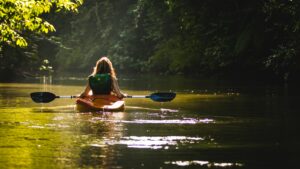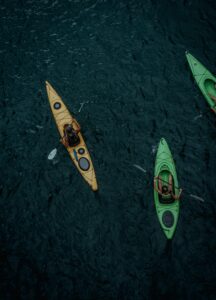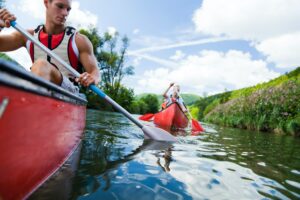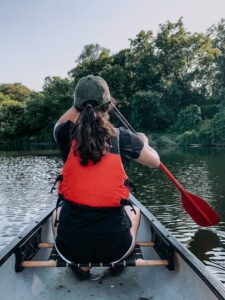Canoeing, from the outside, looks awfully easy, just like other types of paddling. You might see others glide effortlessly through the water without a thought, and it seems you need little more than a breeze to move you along the crystal highway between the trees.
Wait! Though the serenity aspect of this scene is true, the movement is not. Effectively maneuvering a canoe is actually a highly involved task, and requires a significant level of mindfulness and technique. In this article, we’ll cover safety tips and strategies for making your future canoeing trips a success.
Safety First

When it comes to any activity in the wilderness, safety should always be top of mind. For your canoe, you should think about:
Load Capacity
Overloading a canoe will cause it to become very hard to maneuver and dangerously easy to tip due to how low it sits in the water. Most canoes max out at 940 lbs. Even if the two adult riders only equal 350 lbs, this leaves only 550 lbs maximum for equipment, which can be used up quickly if packing for a very long trip.
It also is never advised to actually try and meet this maximum weight. Generally, any amount of weight over 500 lbs will have a noticeable impact on canoe balance and overall agility.
Material
Canoes are primarily made of two different materials: Kevlar and aluminum. These two materials, based on which makes up your canoe, will have different impacts on the overall safety of your canoe. In most cases, an aluminum canoe is considered to be the safest type. This is because they are the most resilient to physical damage, such as scraping on a rock beneath the water. Aluminum canoes are also quite impervious to rough weather-;they hold fast on a path through strong winds, and they can keep quite steady when faced with small white-capped waves.
Kevlar canoes do indeed have perks of their own though. For one, they are much more maneuverable than any aluminum canoe. Their light yet strong frame proves wonderful for any eager canoer, as it is very easy to get going quite fast while still being able to make a quick turn if required.
Life Jackets
Hopefully this one is obvious, but it cannot be emphasized enough! Life jackets are number one when it comes to safety on canoes, and should be worn every time you go out on the water.
There are actually many life jackets that are made specifically for canoeing, designed to be breathable and comfortable. Not sure which life jacket would be best for your trip? We covered some of the best options and what to look for here.
How to Get Comfortable Canoeing

If you’re completely new to canoeing, you first need to learn how to actually paddle in a canoe. To do this, it is best to try and find some sort of local bay or harbor that has minimal motor boat traffic. Bonus points if that area is very low-wind and minimal wake as well! A large pond would also work great for this.
As far as getting a canoe goes, you could take a variety of routes. If you wanted, you could just buy a new or used canoe outright and get out there. Alternatively, you could borrow or rent one first to get a feel of the mechanics. If you plan on often using the canoe with a partner, it would be best to practice with them as well.
Here are a two great exercises to practice while learning how to canoe:
Determine canoeing positions (if canoeing with a partner)
The canoe has two basic paddling positions, which are bow and stern. The canoeist who is at the bow, the front of the canoe, is in charge of the speed of the canoe. Their primary job is keeping the canoe going fast. Typically, the less-strong member of a canoeing duo will be in the bow position.
The canoer who is at the stern, which is the back of the canoe, is in charge of steering the canoe. This position oftentimes will require a significant amount of strength. Actually turning and maneuvering the canoe takes a great deal of effort, and you must constantly be in communication with your bow in order to keep the canoe heading in the direction you want it to.
Get Comfortable in the Canoe
It is critical to get comfortable in the canoe, so you feel as stable as possible, not wobbly, and that you are able to torque a paddling stroke without feeling unstable. A big difference in canoeing vs. kayaking is that you sit much higher in a canoe. While this allows you to have control of your paddle in the water in a much better way, it also means you are naturally a little tippier.
If you are have a choice in canoes and you are new to it, consider opting for a canoe with a seat where you sit a bit lower. It will feel more stable.
Practice Paddle Strokes
Paddle strokes may be something you struggle with when you’re getting started, but practice makes perfect. Though paddling forward on one side will eventually turn you to the opposite side, it is much more efficient to use special paddle strokes in order to turn efficiently.
Let’s quickly look at the three main paddle strokes you should be using while canoeing:
Forward and Backward Strokes

This is the stroke that everybody envisions when they think of paddling a canoe, and it generally is used to keep the canoe going straight in one direction. To keep a canoe going on a solid path forward, the bow will be paddling on one side, and the stern will paddle on the other.
C-strokes
Performed by making a C-shape that faces outwards from the canoe, this stroke is used to turn the canoe opposite of the stern. For example, if a stern performed a C-stroke on the left side of the canoe, the canoe would turn towards the right. Inversely, if the C-stroke is performed the opposite way, it will turn the canoe towards the side of the stern. Be aware that this stroke does require a fair amount of force!
J-strokes
Performed by making a J-shape that ends pushing away from the canoe, J-strokes are a type of stabilizing stroke that helps a canoe maintain a straight direction in the face of strong winds or when the canoe is being piloted solo. Though it is not too commonly used by canoeing teams, it is a great tool for keeping a canoe on a steady trajectory. Like the C-stroke, this stroke also requires a solid force output by the stern!

After you have gone through and practiced these things, the only thing you have to worry about is experience! Indeed, it is time that will strengthen your confidence and skills with canoes, and it will not take more than a few trips for this basic knowledge to have a firm place in your mind. Have fun, and be safe!







